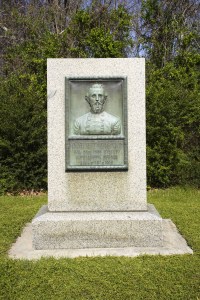I received a really nice message from Sheilah Broughton, who is the G-G-G niece of Colonel William W. Witherspoon, who commanded the 36th Mississippi Infantry. I have had a interest in the 36th Mississippi for a number of years, as I had a G-G-G uncle, James M. Godwin, who served as a private in Company I, “Stephens Guards,” of the 36th Mississippi.

In her note Sheilah asked about where the 36th Mississippi was stationed during the siege of Vicksburg, and I thought the answer would make an interesting post for the readers, so here we go.
Raised in the spring of 1862, the 36th Mississippi was a veteran regiment by the time of the siege of Vicksburg, having been blooded in the battles of Iuka and Corinth in 1862. When the 1863 campaign for Vicksburg kicked off the regiment was part of Brigadier General Louis Hebert’s brigade, which consisted of the following units: 3rd Louisiana Infantry, 21st Louisiana Infantry, 7th Mississippi Infantry Battalion, 36th Mississippi Infantry, 38th Mississippi Infantry, and the 43rd Mississippi Infantry.
Hebert’s brigade was stationed just north of Vicksburg at Snyder’s Bluff while battles of Port Gibson, Raymond, Jackson, Champion Hill and Big Black River were fought. After the Confederate defeat at Champion Hill on May 16, 1863, General John C. Pemberton sent orders for the troops stationed at Snyder’s bluff to march to Vicksburg. Hebert quickly complied with this order, and marched his men into the Vicksburg defenses.

Hebert was ordered to the earthworks in rear of the city and charged with defending the line of entrenchments between the Graveyard Road and the Jackson Road. Hebert deployed his brigade in the following order from left to right: the 36th Mississippi held the Stockade Redan, a large earthwork fort guarding the Graveyard Road; next came the 7th Mississippi Battalion, 37th Mississippi, 38th Mississippi, and 43rd Mississippi; the 3rd Louisiana held a redan north of the Jackson Road, and the 21st Louisiana anchored the brigade right flank in the Great Redoubt on the south side of the Jackson Road.
Because the Graveyard and Jackson Roads were natural avenues of approach to the city, the section of line held by Hebert’s men was destined to be the scene of some of the most intense fighting of the siege.

On May 19th, Union forces assaulted the Confederate defenses, and the Stockade Redan was a focal point of the union attack. Sergeant George Powell Clarke, a member of Company C “Harper Reserves,” of the 36th Mississippi wrote this account of the attack:
“At 10:00 A.M. the firing ceased and the Federals advanced in two lines of battle, halted about 300 yards from our position to reform their lines. Numbers of battle flags could be seen just behind the hill, waving in the morning breeze. We could plainly hear when the order was given to advance; the flags were seen mounting up the hill, and soon the long, glittering line of bayonets came in sight, as with martial tread this tremendous war machine marched to the attack. On reaching the top of the hill and coming into plain view, they gave a prolonged yell, and broke into a double quick towards our lines…At the proper time our batteries opened on them with with grape, canister, and shrapnel shells, which told fearfully on their crowded ranks. When they had reached within fifty yards of our lines we opened upon them with musketry, using the ‘buck and ball’ cartridge with murderous effect…But they were brave men and did not falter, though hundreds were falling all around them, until within a few feet of us. They then wavered, rallied once, but finally gave way and retreated to their own position.” – REMINISCENCE AND ANECDOTES OF THE WAR FOR SOUTHERN INDEPENDENCE by George Powell Clarke, pg. 100
The Union forces attempted a second assault on Vicksburg’s defenses on May 22, but met with the same result. Sgt. Clarke wrote that when the Yankees attacked,
“A withering fire of musketry, grape, canister and shells greeted them as they came in sight, and men fell like grass before the reaper…Here, now, the eye witness could have seen war in all its awful sublimity and grandeur.”
After the failure of the May 22 assault, General Ulysses S. Grant decided to besiege the city and starve the Rebel garrison into submission. For the 36th, the war became a waiting game in the trenches with the threat of death a constant companion.
On June 2, 1863, the 36th Mississippi was moved to a new position line the line on the brigade right flank. If you tour the Vicksburg National Military Park, the marker for this position is located about 200 yards south of the Louisiana State Memorial. The regiment remained in this position for the remainder of the siege.
The siege of Vicksburg ended on July 4, 1863, and the survivors of the 36th Mississippi stacked their muskets and marched out of the earthworks they had defended so well. The regiment had suffered terribly during the siege: of the approximately 300 men in the unit when the fighting began, 28 were killed and 72 wounded.
A very enjoyable article — provided much new material for my understanding
Don Ernsberger
author – Also For Glory – The Pettigrew-Trimble Charge at Gettysburg
http://www.AlsoForGlory.com
Thank you so much for this information!!!
Sheilah Broughton
I am looking for the grave of my great=great grandfather, Riden M Thompson. Some of his muster cards list him as RM Thompson. One list his death in he hospital of Hazelhurst,Mississippi, which is in Copiah County. He was born there, and many family members are buried in the Bethel Baptist Church cemetery, but I could not locate Riden. Sadly, he is being listed on several Ancestry.com family trees as buried in Memphis,TN, but after much work by a professional Genealogical researcher, we have found that to be a Pvt. Richard M.Thompson from Pennsylvania. Any information on Riden (some have it spelled Rider) Thompson, please contact me at .Thank you!
Sandra, I’m afraid I don’t know anything about the burial place of your relative, but if there is anything I can do to help, you can contact me at championhilz@att.net
I am currently preparing for the upcoming, big, living history at Vicksburg from 3-5 May 2013. My company is the 93rd Illiniois. I have been reading everything I can find about this unit and other units which participated with or near the unit. I just found online the Seth Wells diary about his time just before and during the siege. He was in the 8th Illinois at this time. During the siege, he reported there was infrequent conversation with Confederates opposite him while he was on the skirmish line. The Confederates were the 36th Mississippi. Wells identifies them by name.
Here’s a link to his diary : http://archive.org/details/siegeofvicksburg00well which can be viewed online or can be downloaded in many different formats for later review.
Here’s a link to wikipedia where I have zoomed in on the relevant area : http://wikimapia.org/#lat=32.3554102&lon=-90.8462011&z=17&l=0&m=b In the exact middle of the page (where there’s the “X”) is the location for two markers for the 8th Illinois. Hover your mouse over each and the identification will be revealed. From their location, look about two inches to the left (due west) at the hard road. There you will find the marker for the 36th Mississippi. Witherspoon’s relief is a little to the southwest of the 36th’s marker.
Thanks so much for the information! If you are looking for another account from the Confederates near the 93rd Illinois, I recommend “The Rank and File at Vicksburg” by James Henry Jones, who was Captain of Company D, 38th Mississippi Infantry. The 38th was in the same brigade as the 36th Mississippi. It is in Vol. 7 of the Publications of the Mississippi Historical Society.
Got it. Hadn’t noticed that series of books before. Another solid source to review. For anyone following this thread, here’s that link : http://archive.org/details/publicationsmis05socigoog
Here’s the irony to this series : For all the study I have done on this campaign through online sources, hardcopy volumes and walking the grounds, this series was scanned by google from the shelves of the University of California library. That’s my alma mater. I probably walked by this very series of books at one time or another a few decades ago. It’s like going full circle.
Here’s another really good source with a good bit of Vicksburg material:
Clarke, George Powell. [Pvt., Sgt., Co. C, 36th Mississippi Infantry] Reminiscence and Anecdotes of the War for
Southern Independence. (Decatur, MS: Privately published, 1996.)
Hey, thanks for your work. According to the records at the Old Courthouse in Vicksburg at least on of my g-g-grandfathers (Samuel Hollingsworth) was with the 36th Miss Inf at that time. I’m beginning to research the possibility that another of my g-g-grandfathers (Wellington Duke) was there as well.
My g-g-grandfather, William P. Tingle, was a private in Company C — the Harper Reserves — of the 36th Mississippi Infantry Regiment. He died in 1917, a year after applying for his Confederate pension. His daughter Lennie was my g-grandmother, and she was his youngest child (of around 13 children), born in 1890 to his second wife when he was 57 years old. According to family stories, his first wife, Hancey Stapleford Tingle, was home tending to their farm in Newton County, MS while he was fighting in the war, and she was abducted by some renegade soldiers who rode up to their farm. They threw a rope around her neck and carried off into the woods, and she was never seen again, leaving three young children motherless. He married my g-g-grandmother, Cynthia Jane Moore, around 1869. Both William Tingle and his wife Cynthia were themselves grandchildren of Revolutionary War veterans. I was a pallbearer at my g-grandmother Lennie’s funeral in ’76. We buried her next to her Confederate father in Centerville, MS. It was interesting to read Sergeant George Powell Clarke’s account of Company C’s fight at Stockade Redan, guarding Graveyard Road.
Great post. My great grandfather, John W Ellis, was in Co E of the 7th Miss. Battalion. I’ve been researching his unit and service and have found, as in this post, that it’s a big help to broaden the search to other units that were under the same command.
Very interesting article. My great, great grandfather served with the 7th Mississippi Infantry.
My great grandfather James Nathaniel Denison served in 36th. He surrendered at Vicksburg, fought in Franklin, TN, rose to rank of Captain, later capture at Spanish Fort, Alabama & spent the last of the war on Ship Island, involuntarily.